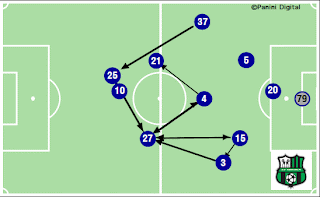The disciple and his professor will
meet for the first time as rival managers as Chelsea prepares to face Tottenham
at White Hart Lane. Villas-Boas had worked under
Mourinho at Porto and Chelsea as chief scout until he thought to deserve more power on the training field. But he had
his bigger involvement request at Inter scuffled. So
he tried to build his own reputation pursuing his ambitions. We don’t know exactly
when the relationship between him and Mourinho was broken. The history told Villas-Boas
attempted to get a first team coaching stint in the summer of 2009 at Braga but he
failed before to get his first managerial job at Académica de Coimbra in the
same year.
"I worked for José for seven
years but we haven't spoken for quite some time," he said. "I
haven't even got his number now. We had a great personal and
professional relationship before, that we don't have now," he said.
"I don't think we need explanations on friendship and personal
relationships. But our relationship broke down.”
The relationship between the Portuguese managers started back to 1994, when
Mourinho was the Bobby Robson's interpreter at Sporting Lisbon and Villas-Boas a
young student of the game living near to the Englishman’s apartment.
Villas-Boas wrote a paper with a tactical analysis about Domingos Paciência that
made Robson so impressed to lure him and send in Scotland to gain his coaching badge. When Mourinho returned to Porto as
manager in 2002 he asked him to create and run the scouting department.
A things
is sure: Villas-Boas’ philosophy is far from that of Mourinho. While Mourinho
put emphasis on transitions, Villas-Boas likes a more complex brand of football.
Villas-Boas’ failed stint as Chelsea manager in 2011-12 is part of the story.
Mourinho is
a fan of defending deep. His 4-3-3 at Chelsea was more a 4-5-1, with players
asked to collapse behind the ball as quick as possible in the defensive phase. Villas-Boas
approach was different. He was looking for a heavy pressing to win the ball
back quickly. He wanted a high defensive line and this was a point that made him
struggling at Chelsea, with John Terry & Co. uncomfortable to play this
way.
Mourinho switched from his
classic 4-3-3 to a 4-2-3-1 this season, being flexible enough to adapt his
ideas to his players’ skills. “We will
play 4-2-3-1 in the first game, my favourite system, though sometimes I change
the triangle and play with one in front of the defenders and two players up,”
he said. “Other times I play
with double midfielders and a number ten… but in another match I could change
it. If we are losing, we might need to have two pure strikers.” On his
side, Villas-Boas stuck with his usual formation. The 4-3-3 system at Porto was built around
Fernando moving forward despite being a holding midfielder, and switching spot
with Freddy Guarin who usually drop deep if Fernando advanced and with Joao
Moutinho acting like a classic box to box midfielder. Villas Boas tried to
reply this midfield rotation at Chelsea but it didn’t work as the same manager
admitted:
“Our No 6 [at Porto, usually Fernando] sometimes became a more attacking
midfielder and we tried to do that here [at Chelsea]. We decided it doesn’t
work here, so that’s one of the things I have adapted. You lose a little bit of
balance in the Premier League if you play that way. Transitions here are much
more direct, making the importance of the No 6 to stay in position most
decisive.”
The midfield rotation
creates a mobile midfield, and allows team to make free a midfielder in the
build up if opponents are chasing the deep-lying midfielder. Now, he has the chance
to reply this formation with Tottenham. Sandro, Moussa Dembele and Paulinho suit perfectly
his needs. And the 4-2-3-1
version he sometimes employed there is also similar to 4-3-3 system he ran at Porto.








